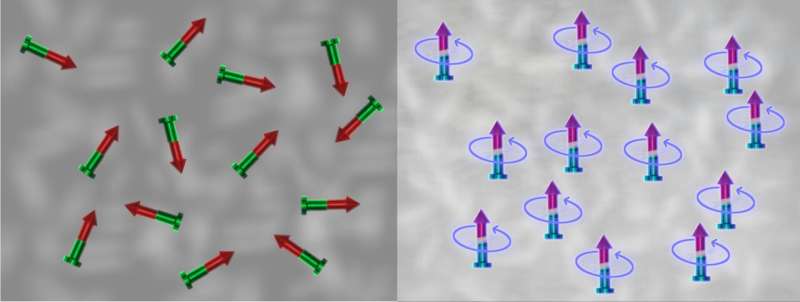Programmable interaction between quantum magnets

The forces between particles, atoms, molecules, or even macroscopic objects like magnets are determined by the interactions of nature. For example, two closely lying bar magnets realign themselves under the influence of magnetic forces. A team led by Prof. Dr. Matthias Weidemüller and Dr. Gerhard Zürn at the Center for Quantum Dynamics of Heidelberg University has now succeeded in its aim to change not only the strength but also the nature of the interaction between microscopic quantum magnets, known as spins. Instead of falling into a state of complete disorder, the especially prepared magnets can maintain their original orientation for a long period. With these findings, the Heidelberg physicists have successfully demonstrated a programmable control of spin interactions in isolated quantum systems.
Magnetic systems can exhibit surprising behavior when they are prepared in an unstable configuration. For example, constraining a collection of spatially disordered magnetic dipoles, such as bar magnets, to be aligned in the same direction, will lead to a subsequent reorientation of the magnets. This ultimately results in an equilibrium in which all magnets are randomly oriented. While the majority of investigations used to be limited to classical magnetic dipoles, it has recently become possible to expand the approaches to quantum magnets using what are called quantum simulators. Synthetic atomic systems mimic the fundamental physics of magnetic phenomena in an extremely well-controlled environment where all relevant parameters can be adjusted almost at will.
In their quantum simulation experiments, the researchers used a gas of atoms that was cooled down to a temperature near absolute zero. Using laser light, the atoms were excited to extremely high electronic states, separating the electron by almost macroscopic distances from the atomic nucleus. These "atomic giants," also known as Rydberg atoms, interact with each other over distances of almost a hair's breadth. "An ensemble of Rydberg atoms exhibits exactly the same characteristics as interacting disordered quantum magnets, making it an ideal platform to simulate and explore quantum magnetism," states Dr. Nithiwadee Thaicharoen, who was a postdoc on Prof. Weidemüller's team at the Institute for Physics and now continues her research as a professor in Thailand.
The essential trick of the Heidelberg physicists was to steer the dynamics of the quantum magnets by adopting methods from the field of nuclear magnetic resonance. In their experiments, the researchers apply especially designed periodic microwave pulses to modify the atomic spin. A major challenge was to precisely control the interaction between the atomic spins using this technique, known as Floquet engineering. "The microwave pulses had to be applied to the Rydberg atoms at timescales of a billionth of a second, with these atoms being super-sensitive at the same time to any external perturbation, however tiny, like minute electric fields," says Dr. Clément Hainaut, a postdoc on the team who recently moved to the University of Lille (France). "We nonetheless succeeded in stalling the spin's seemingly inevitable reorientation and maintaining a macroscopic magnetisation through our control protocol," explains doctoral student Sebastian Geier. "Using our Floquet engineering approach, it should now be possible to reverse the timeline such that the spin system inverts its evolution after having gone through a very complex dynamic. It would be like a broken glass magically reassembling itself after it has crashed onto the floor."
The studies are an important step towards a better understanding of basic processes in complex quantum systems. "After the first and second quantum revolution, which led to the understanding of the systems and the precise control of single objects, we are confident that our technique of dynamically adjusting interactions in a programmable fashion opens a path to Quantum Technologies 3.0," concludes Matthias Weidemüller, professor at the Institute for Physics and Director of Heidelberg University's Center for Quantum Dynamics.
More information: Sebastian Geier et al, Floquet Hamiltonian engineering of an isolated many-body spin system, Science (2021). DOI: 10.1126/science.abd9547
Provided by Heidelberg University





















